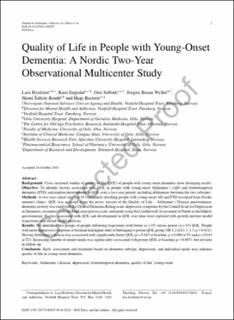| dc.contributor.author | Hvidsten, Lara H. Thomasgaard | |
| dc.contributor.author | Engedal, Knut | |
| dc.contributor.author | Selbæk, Geir | |
| dc.contributor.author | Wyller, Torgeir Bruun | |
| dc.contributor.author | Saltyte Benth, Jurate | |
| dc.contributor.author | Kersten, Hege | |
| dc.date.accessioned | 2021-03-17T14:03:46Z | |
| dc.date.available | 2021-03-17T14:03:46Z | |
| dc.date.created | 2018-12-14T14:03:38Z | |
| dc.date.issued | 2019 | |
| dc.identifier.citation | Journal of Alzheimer's Disease. 2019, 67 (1), 197-210. | en_US |
| dc.identifier.issn | 1387-2877 | |
| dc.identifier.uri | https://hdl.handle.net/11250/2733976 | |
| dc.description.abstract | Background:Cross-sectional studies of quality of life (QOL) of people with young-onset dementia show diverging results. Objective:To identify factors associated with QOL in people with young-onset Alzheimer’s (AD) and frontotemporal dementia (FTD) and explore development in QOL over a two-year period, including differences between the two subtypes. Methods:A two-year cohort study of 88 community-dwelling people with young-onset AD and FTD recruited from Nordic memory clinics. QOL was assessed using the proxy version of the Quality of Life – Alzheimer’s Disease questionnaire, dementia severity was rated with the Clinical Dementia Rating scale, depressive symptoms by the Cornell Scale for Depression in Dementia, awareness with the Reed anosognosia scale, and needs using the Camberwell Assessment of Needs in the Elderly questionnaire. Factors associated with QOL and development in QOL over time were explored with growth mixture model trajectories and mixed model analyses. Results:We identified two groups of people following trajectories with better (n = 35) versus poorer (n = 53) QOL. People with more depressive symptoms at baseline had higher odds of belonging to poorer QOL group, OR 1.2 (CI 1.1; 1.5, p = 0.011). Having Alzheimer’s disease was associated with significantly better QOL (p = 0.047 at baseline, p = 0.009 at T1 and p = 0.033 at T2). Increasing number of unmet needs was significantly associated with poorer QOL at baseline (p = 0.007), but not later in follow-up. Conclusion:Early assessment and treatment based on dementia subtype, depression, and individual needs may enhance quality of life in young-onset dementia.
Keywords: Alzheimer’s disease, depression, frontotemporal dementia, quality of life, young-onset | en_US |
| dc.language.iso | eng | en_US |
| dc.rights | Navngivelse 4.0 Internasjonal | * |
| dc.rights | Navngivelse-DelPåSammeVilkår 4.0 Internasjonal | * |
| dc.rights.uri | http://creativecommons.org/licenses/by-sa/4.0/deed.no | * |
| dc.title | Quality of Life in People with Young-Onset Dementia: A Nordic Two-Year Observational Multicenter Study | en_US |
| dc.type | Peer reviewed | en_US |
| dc.type | Journal article | en_US |
| dc.description.version | submittedVersion | en_US |
| dc.rights.holder | CC BY 4.0 | en_US |
| dc.source.pagenumber | 197-210 | en_US |
| dc.source.volume | 67 | en_US |
| dc.source.journal | Journal of Alzheimer's Disease | en_US |
| dc.source.issue | 1 | en_US |
| dc.identifier.doi | 10.3233/JAD-180479 | |
| dc.identifier.cristin | 1643415 | |
| cristin.unitcode | 1991,9,2,0 | |
| cristin.unitname | Avd Rusrelatert psykiatri og avhengighet | |
| cristin.ispublished | true | |
| cristin.fulltext | original | |
| cristin.fulltext | preprint | |
| cristin.qualitycode | 1 | |

